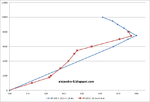silence
Senior Airman
Can someone explain why the K-4 is noticeably faster than the G-10?:
342mph vs. 378mpf at s/l
426mph (max) vs. 435mph at approx.24,500 feet
K-4: 452mph max at 19,685
plus what looks like a much higher climb rate for the K-4
Is it simply the drag from the lower now cowl blister fairings? I can't imagine the G-10 being heavier enough to account for the
342mph vs. 378mpf at s/l
426mph (max) vs. 435mph at approx.24,500 feet
K-4: 452mph max at 19,685
plus what looks like a much higher climb rate for the K-4
Is it simply the drag from the lower now cowl blister fairings? I can't imagine the G-10 being heavier enough to account for the


